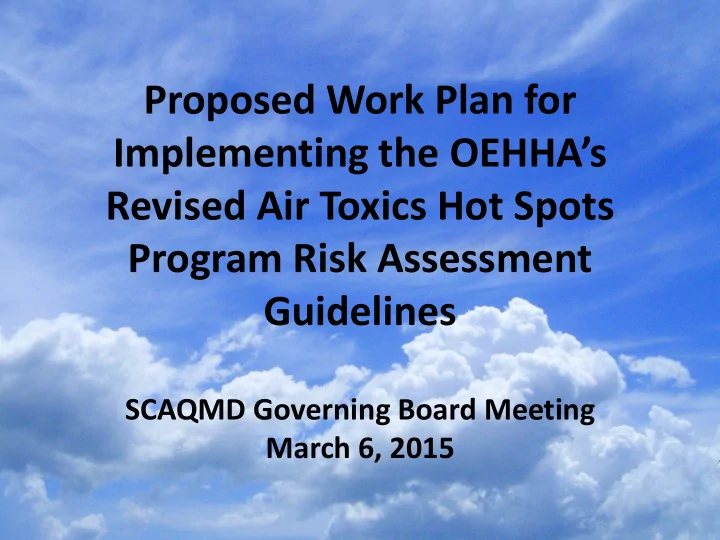

Proposed Work Plan for Implementing the OEHHA’s Revised Air Toxics Hot Spots Program Risk Assessment Guidelines SCAQMD Governing Board Meeting March 6, 2015
OEHHA Revised Risk Guidance • SB 25 required that the special susceptibility of infants and children be considered in assessing the health risks associated with air toxics • Office of Environmental Health Hazard Assessment (OEHHA) revising Risk Assessment Guidelines – Incorporates new studies on childhood sensitivity – Incorporates new data on exposure (e.g. breathing rate and time at home) • Cancer risk estimates for residential exposures will increase ~3 times (some cases 6 times higher) • Cancer risk estimates for worker exposure no substantial change
OEHHA Revised Risk Guidelines Impact On Cancer Risk Residential / Sensitive Receptor Cancer Risk (Increased) Worker Receptor Cancer Risk (Slight Change) No Change Revised Quantification of Methodology Facility for Estimating Emissions – Cancer Risk (No Increase in (Childhood Toxic Emissions) sensitivities and breathing rates)
“Umbrella Toxics Rules” • Rule 1401 – Toxic requirements for new and modified permitted sources • Rule 1401.1 – Toxic requirements for new and modified permitted sources near schools • Rule 1402 – Toxic requirements for existing facilities • Rule 212 – Noticing for new and modified permitted sources
SCAQMD’s Air Toxics Program Draft 2010 2000 Air Clean MATES I Toxics 2004 ATCP EJ Communities Rule 1401 Control Plan Addendum Initiatives Plan 2014 1990 1994 1997 1998 2000 2003 2004 2005 2010 Rule 1402 MATES II Mates III Cumulative Impacts (AB 2588 Strategies Toxics “Hot Spots”) White Paper Represents adoption of a stationary source-specific toxic rule
Trends in Cancer Risks Since 1990 (Excludes diesel PM) 1000 Burbank Los Angeles Inhalation Cancer Risk (in a million) 800 Long Beach Riverside 600 Simi Valley 400 200 0 1990 1992 1994 1996 1998 2000 2002 2004 2006 2008 2010 2012 Year
Risk Assessment & Risk Management Risk Risk • ACTION taken based on • ACTION taken based on consideration of Risk Assessment • Provides INFORMATION on Assessment Management • Provides INFORMATION on • Regulatory decisions on how to consideration of Risk Assessment potential health risk • Regulatory decisions on how to potential health risk manage risk which can include • Scientific factors such as • Scientific factors such as manage risk which can include schedule, risk thresholds, technical toxicology, chemistry, schedule, risk thresholds, technical toxicology, chemistry, feasibility, cost epidemiology feasibility, cost epidemiology
Process March April 2015 2015 • OEHHA CARB and CAPCOA Approves Air Districts Approve Risk Revised Implement Management Guidelines Guidelines Guidelines • HARP 2* to be Released to Public * Hot Spots Assessment Reporting Program 2 (HARP 2) will incorporate new air dispersion model AERMOD and the Revised OEHHA Guidelines.
Affected Programs Permitting AB2588 • Rule 1401 – New and Modified • AB2588 Core Facilities Permitted Sources • AB2588 Industry-Wide Facilities • Rule 1401.1 – New and Relocated • Rule 1402 – Control of Toxic Air Facilities Near Schools Contaminants from Existing Sources Revised OEHHA Guidance Public Noticing CEQA • Rule 212 – New or modified permits • Air Toxics Analysis for • AB2588 Facilities • Construction Phases • Operational Phases
Near-Term Needs Interim permitting • Amend Rule 1401 provisions for specific • Develop source-specific rules, if needed • Update supporting materials source categories Address inconsistencies • Amend Rule 1401 and 1401.1 • Amend Rule 1402 with Revised OEHHA • Amend Rule 212 Guidelines Implement AB2588 • Amend Rule 1402 using Revised OEHHA • Revise Prioritization Procedures • Revise Public Notification Guidelines Guidelines • Develop guidance for CEQA Guidelines Policy for CEQA Projects • Implement SCAQMD Lead Agency Projects first
Permitting • Interim provisions may be needed for specific source categories that cannot meet Rule 1401 risk limits • Recommendation: – Amend Rule 1401 to narrowly provide temporary relief from Revised OEHHA Guidelines for new and modified sources that cannot be permitted, if needed (No backsliding) Schedule: May 2015
Rule Amendments to Address Inconsistencies • Rules 1401, 1401.1, 1402, and 212 include references based on current health risk guidelines such as exposure duration • Recommendation: – Amend Rules 1401, 1401.1, 1402, and 212 to reference Revised OEHHA Guidelines Schedule: May 2015
AB2588 • Health risk assessments required under Toxics Hot Spots Program shall be prepared in accordance with Guidelines established by OEHHA (Health and Safety Code § (b)(2)) – SCAQMD must use Revised OEHHA Guidelines for HRAs under the Hot Spots Program • Recommendation: – All HRAs not yet approved will be required to use Revised OEHHA Guidelines
AB2588 (Continued) • Other action items to implement Revised OEHHA Guidelines: – Update Supplemental HRA Guidelines for AB2588 – Revise Prioritization Procedures – Revise AB2588 Public Notification Procedures Schedule: May 2015
CEQA • Revised OEHHA Guidelines will affect construction and operational phases, particularly diesel and mobile sources •SCAQMD’s CEQA Handbook references Rule 1401 for risk assessment methodology • Recommendation: • Reference Revised OEHHA Guidelines • Develop recommendations for use of Revised OEHHA Guidelines for CEQA Projects (Risk management decisions – Governing Board) • Implement SCAQMD Lead agency projects first, then other lead agency projects • Schedule: May 2015
Outreach and Communication • CARB and CAPCOA to develop a statewide outreach and communication effort • Messaging is important – Air toxic emissions have not increased, state has changed how air toxics risks are estimated • Recommendation: – Initiate public workshops throughout the Basin in March – Conduct individual stakeholder meetings – Develop outreach and communication materials – Continue working with CARB and CAPCOA to develop a statewide outreach and communication effort
General Timeline OEHHA Approve Revised Guidelines Public Release of HARP2 Approve Risk Management Guidelines Mar May Aug Oct Jan Apr Aug Oct 2015 2015 2015 2015 2016 2016 2016 2016 Outreach, Communication and Training Permitting CEQA AB2588
Recommended Action • Implement enhanced outreach and risk communication activities • Proceed with development of adjustments to SCAQMD’s various programs related to Risk Assessment • Updates to the Stationary Source Committee during rule development process
Recommend
More recommend